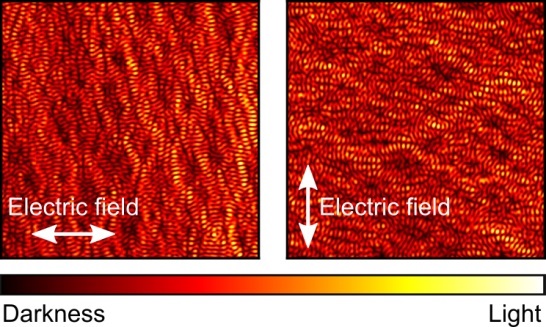August 23, 2016
Darkness can be found in light. This typically happens at an optical vortex: a point in which the amplitude of light is zero and where it twists like a corkscrew. In fact, the projection of a vortex on a flat surface looks like a ring of light, with a dark spot in the center. Researchers in the group of FOM workgroup leader Kobus Kuipers studied how a multitude of dark optical vortices are distributed in space with respect to each other. They demonstrated that the vectorial nature of light plays an important role: the chance of finding another vortex is different for directions along or perpendicular to the vector field direction. The researchers publish their findings in the journal Physical Review Letters on 23 August.
A liquid of vortices
When many waves with random phases come together from all directions, a multitude of optical vortices appear in the resulting interference pattern. This holds for all waves. Researchers M.R. Dennis and M.V. Berry predicted that for scalar waves the vortices would be distributed in space like the ions in an ionic liquid: for any given vortex the chance of finding another at a certain distance is a damped oscillating function with a typical distance of half the wavelength. That means that the positions are correlated. The chance also depends on whether the vortices have the same charge, i.e., is their corkscrew left- or right-handed: unlike the ions in the liquid oppositely charged vortices can approach each other as close as they like, since they themselves are infinitely small. Like in a liquid it doesn’t depend on direction, there are no preferred directions. However, when considering light as a wave we have to remember that this is a vector wave. The electromagnetic field that constitutes light waves oscillates and vectors determine the direction in which this oscillation takes place.
Correlated vortices (or not)
In the paper published on 23 August, the researchers demonstrate that the distribution of the optical vortices in random light waves is strongly affected by the fact that light is a vector. By trapping light in a chaotic cavity a random light field was created. With a dedicated microscope the relative positions and charges of thousands of vortices were determined. In addition the local field vectors of the light were mapped. It was clear that the chance of finding another vortex relative to another depended on the direction of the field. First author Lorenzo De Angelis says: "It is intriguing to observe that depending on the direction along which you look for the next, vortices far away from each other can still be correlated, or not; it depends on whether you look along or perpendicular to the field direction."
The ideas and methods that the researchers present do not only apply to light waves, but they are ready to use for every physical quantity that is described by a vector wave.
Reference
L. De Angelis, F. Alpeggiani, A. Di Falco and L. Kuipers, Spatial distribution of phase singularities in optical random vector waves, Physical Review Letters













